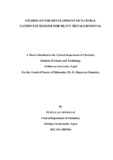Please use this identifier to cite or link to this item:
http://archive.nnl.gov.np:8080/handle/123456789/325Full metadata record
| DC Field | Value | Language |
|---|---|---|
| dc.contributor.author | Homagai, Puspa Lal | |
| dc.date.accessioned | 2018-06-03T10:38:51Z | |
| dc.date.accessioned | 2020-08-21T07:54:51Z | - |
| dc.date.available | 2018-06-03T10:38:51Z | |
| dc.date.available | 2020-08-21T07:54:51Z | - |
| dc.date.issued | 2018-06-03 | |
| dc.identifier.uri | http://103.69.125.248:8080/xmlui/handle/123456789/325 | - |
| dc.description | A thesis submitted to the Central Department of Chemistry, Institute of Science and Technology, Tribhuvan University, Nepal for the award of Doctor of Philosophy (Ph. D.) Degree in Chemistry, 2012. | en_US |
| dc.description.abstract | Two types of novel bioadsorbents such as charred xanthated sugarcane bagasse (CXSB) and charred aminated sugarcane bagasse (CASB) are investigated. This research work elucidates the uptake performance of biosorbent for the sequestration of heavy metal ions such as Cd2+, Pb2+, Cu2+, Ni2+ and Zn2+, respectively. Xanthated and aminated biosorbent prepared from sugarcane bagasse under specific experimental conditions were characterized with FT-IR, TGA/DTA, SEM, Zeta potential and Elemental analysis. Batch adsorption experiments were performed at eight different initial metal ion concentrations (25, 50,100, 200, 400, 600, 800, 1000 mg/L), at 293K temperature, while pH of the solutions was varied from 1 to 7. The results indicated that the uptake performance of CXSB and CASB biosorbent significantly changed with pH, concentration of metal ions and temperature. The selectivity order in the removal of heavy metals at pH around 4 follows the order Pb> Cu > Ni > Cd >Zn for CXSB whereas the order Pb> Cd > Zn > Ni >Cu for CASB. Moreover Irwing- Williams Series support the bindings’ mechanism for Cu2+, Cd2+,Pb2+, Zn2+and Ni2+ ions onto both the modified biopolymers. Adsorption of heavy metal ions onto both CXSB and CASB biosobents followed pseudo-second order kinetics with faster adsorption within 15minutes to 40 minutes. All the obtained data well followed the Langmuir adsorption isotherm. The positive value of enthalpy change (ΔH) and negative of free energy change (ΔG) shows the adsorption process is endothermic and spontaneous. Moreover, the obtained positive entropy changes (ΔS) shows that an increase in randomness, is associated with the adsorption of metal ions onto the CXSB and CASB biosorbents. As in the case of plastic materials like commercial synthetic cation exchanger, the CXSB and CASB based on sugarcane bagasse developed in our laboratory revealed to be an efficient cation exchanger for removing cadmium, lead, copper, nickel and zinc ions from the aqueous solution. | en_US |
| dc.language.iso | en | en_US |
| dc.subject | Adsorption | en_US |
| dc.subject | Xanthation | en_US |
| dc.subject | Amination | en_US |
| dc.subject | Heavy metals | en_US |
| dc.subject | Sugarcane bassage | en_US |
| dc.title | Studies on the development of natural cation exchanger for heavy metals removal | en_US |
| dc.type | Thesis | en_US |
| Appears in Collections: | 500 Natural sciences and mathematics | |
Files in This Item:
| File | Description | Size | Format | |
|---|---|---|---|---|
| 126 Dr. Puspa Lal Homagai.pdf | 1.95 MB | Adobe PDF |  View/Open |
Items in DSpace are protected by copyright, with all rights reserved, unless otherwise indicated.